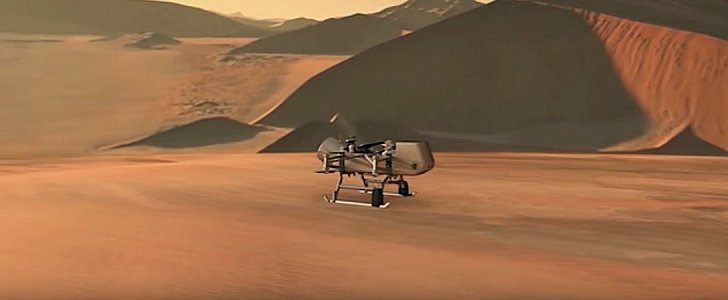The second largest planet in the Solar System, Saturn, has for centuries captivates humans thanks to its unique system of rings and the army of over 60 moons that circle it. Among these moons, Titan has been sung in literature repeatedly, as it is thought to be the most likely place to find life in the immediate neighborhood.
In 2034, we’ll know if we’re the only planet that harbors life in our Solar System. NASA said on Thursday (June 27) that a mission to Titan is being planned with targets never before attempted by humans.
The tool which NASA plans to use for this task is called Dragonfly, and is in fact a drone equipped with eight rotors. Its first landing site is the equatorial region known as the Shangri-La dune fields, but from there the machine will perform a series of flights that will take it to other regions like the Selk impact crater. In all, it’s to be expected Dragonfly will fly more than 108 miles (175 km) on the surface of Titan.
Next year, NASA is sending to Mars a helicopter of sort in an attempt to prove flight is possible on other planets, but Dragonfly’s mission will be the first when a multi-rotor vehicle is used for science on another planet.
Specifically, Dragonfly will study how far prebiotic chemistry progressed on the moon, have a closer look at the moon’s atmospheric, surface and subsurface ocean properties and search for chemical evidence of past life.
The mission will launch in 2026 and will land on Titan eight years later, in 2034. The projected lenght of its mission on the surface is 2.7 years.
“With the Dragonfly mission, NASA will once again do what no one else can do,” said in a statement NASA Administrator Jim Bridenstine.
“Visiting this mysterious ocean world could revolutionize what we know about life in the universe. This cutting-edge mission would have been unthinkable even just a few years ago, but we’re now ready for Dragonfly’s amazing flight.”
The tool which NASA plans to use for this task is called Dragonfly, and is in fact a drone equipped with eight rotors. Its first landing site is the equatorial region known as the Shangri-La dune fields, but from there the machine will perform a series of flights that will take it to other regions like the Selk impact crater. In all, it’s to be expected Dragonfly will fly more than 108 miles (175 km) on the surface of Titan.
Next year, NASA is sending to Mars a helicopter of sort in an attempt to prove flight is possible on other planets, but Dragonfly’s mission will be the first when a multi-rotor vehicle is used for science on another planet.
Specifically, Dragonfly will study how far prebiotic chemistry progressed on the moon, have a closer look at the moon’s atmospheric, surface and subsurface ocean properties and search for chemical evidence of past life.
The mission will launch in 2026 and will land on Titan eight years later, in 2034. The projected lenght of its mission on the surface is 2.7 years.
“With the Dragonfly mission, NASA will once again do what no one else can do,” said in a statement NASA Administrator Jim Bridenstine.
“Visiting this mysterious ocean world could revolutionize what we know about life in the universe. This cutting-edge mission would have been unthinkable even just a few years ago, but we’re now ready for Dragonfly’s amazing flight.”


